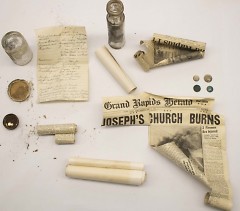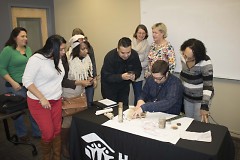On February 10th from 2pm-4pm at The Edge Urban Church (735 Ritzema St. SW) the public is invited to a unified celebration of the Saint Joseph the Worker Church building and its legacy in the Roosevelt Park neighborhood.
The event is free and will have a multi-cultural food buffet, music, activities for kids, and a presentation of historical artifacts from two time capsules found in the cornerstone of the church. There will also be time to share memories of the site and celebrate the future of the neighborhood. The event is hosted by the Roosevelt Park Neighborhood Partner Committee, the Roosevelt Park Neighborhood Association, Habitat for Humanity of Kent County, Grand Rapids Public Schools, and LINC Up.
Though numerous congregations have called the St. Joseph the Worker home during the last century, it has always served as a space of unity for the Roosevelt Park neighborhood.
The original church was built on Rumsey St. SW and was dedicated on February 10, 1889. The structure was home to the St. Joseph the Worker Parish, a predominately Dutch Catholic community. When the original church building burned down in 1953, the church was rebuilt adjacent to the original site in 1954 and a rectory and school were built on the site in the following years.
As the cultural makeup of the neighborhood shifted over time, so too did the church community. Yet it remained a pillar in the neighborhood and still holds fond memories for many who grew up along Grandville Avenue.
About 10 years ago, the St. Joseph the Worker Parish moved out of the Rumsey Street building to their new home in Wyoming, which offered more space to accommodate the growing congregation. A number of small faith communities used the building until 2014 when it was sold to Habitat for Humanity of Kent County.
The church building has been part of ArtPrize for the past three years, including 2017’s installation by Cultura Collective that honored and documented narratives that are crucial to the fabric of the neighborhood, seeking to celebrate the cultural and historic identity of a community during major change.
The legacy of inclusiveness, safety, and community will continue on the site as part of the Plaza Roosevelt development, which will break ground in mid-2018.
Plaza Roosevelt is a neighborhood-driven, mixed-use development led by Habitat for Humanity of Kent County that has sought input from residents, community leaders, arts organizations, health care providers, education institutions and housing providers to develop a site plan that reflects the neighborhood’s greater goals. Neighborhood leaders have been integral to the planning process and involved in all stages.
The original church site will become part of the new Grand Rapids Public Schools dual-immersion high school and a plaza space for community use.
The artifacts were removed from the time capsules and preserved with help from the Grand Rapids Public Museum staff.
Visit the event page on Facebook.
To learn more about the event, the future of the space, or how to get involved in neighborhood leadership contact Israel Ledesma [email protected]
The Rapidian, a program of the 501(c)3 nonprofit Community Media Center, relies on the community’s support to help cover the cost of training reporters and publishing content.
We need your help.
If each of our readers and content creators who values this community platform help support its creation and maintenance, The Rapidian can continue to educate and facilitate a conversation around issues for years to come.
Please support The Rapidian and make a contribution today.


